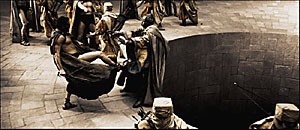“”300″” is a movie adapted from a fictional comic book, inspired by a sensationalized ’60s movie that is roughly based on the Battle of Thermopylae over 2,400 years ago. It does not attempt to be an historically accurate portrayal of what happened. Many critics of the movie cite this as a problem, despite the filmmakers being clear they had no intent to make it such.
However, the movie is an earth-shattering exercise in vivid, effect-based filmmaking and the birth of a new genre of film. Based on a 1998 Frank Miller (“”Sin City””) graphic novel, the movie by director Zack Snyder (2004’s “”Dawn of the Dead””) opens in theaters today.
“”300″” follows Leonidas (Gerard Butler), King of Sparta, through political and emotional battles before finally letting him take the ultimate fight to the Persians as they attempt to invade Greece. These battles make Ridley Scott’s “”Gladiator”” look like slap boxing by comparison.
The story is not deep by any stretch of the imagination. The movie is exactly what is depicted in the extensive promotional campaign: beefed-up warriors in shiny armor, engaging in ultra-violent slow-motion battles. This is what the movie does, but it does it better than any film in history.
The story starts off slowly, but ultimately gets around to what everybody came to see: blood and guts.
“”300″”
Rating: R
Length: 117 min.
Production Company: Warner Bros. Pictures
Everything and anything the movie does, it does in excess.
At the top of this list is violence. From spears piercing fighters’ chests to legs shredding on contact, the blood definitely flies. Basically, it’s like a Gallagher show with humans substituted for the fruit.
The dialog is also a case study in overindulgence. It seems that every line from Leonidas’ mouth after he leaves Sparta is yelled at deafening levels. It’s not really clear if Butler is trying to convey passion or paranoia here.
The one real flaw in “”300,”” and it’s large, is the lack of story and character development. The characters are extremely expendable. There’s no emotional ties formed with the audience, and the people on-screen become more like commodities than humans.
But despite what Internet posts may claim, it’s not an allegory for the war in Iraq. This is painfully obvious, if not through the differences between the events, then by the film being a word-for-word adaptation of a graphic novel written in 1998.
Themes of duty, combat and honor are central to the film (also titles of chapters from the graphic novel). The clear goal of the story is to glorify the concept of making the ultimate sacrifice in battle.
“”300″” and its precursor, “”Sin City,”” are the start of a new genre of big-budget comic exploitation films. Similar to movies like “”Kill Bill”” and next month’s “”Grindhouse,”” the genre takes the aestheticization of violence, but applies it to larger-than-life comic characters. With its vivid and artistic look, “”300″” stretches this idea to the point where the gory violence on screen becomes oddly beautiful at times.
If you want to see limbs getting torn apart, or just enjoy one of the most visually impressive films in history, take a look at “”300″” in theaters.









